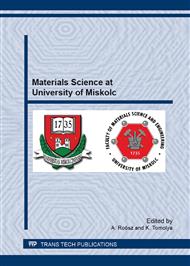[1]
Gácsi Zoltán, Simon Andrea, Pázmán Judit, Fémkompozitok, Miskolci Egyetem, Miskolc, (2011).
Google Scholar
[2]
K. Shorowordi, T. Laoui, A. S. Haseeb, J. L. Celis, Microstructure and interface characteristics of B4C, SiC and Al2O3 reinforced Al matrix composites: a comparative study, Journal of Materials Processing Technology 142 (2003) pp.738-743.
DOI: 10.1016/s0924-0136(03)00815-x
Google Scholar
[3]
T. Pieczonka, Th. Schubert, S. Baunack, B. Kieback: Dimensional behaviour of aluminium sintered in different atmospheres, Materials Science and Engineering A 478 (2008) 251–256.
DOI: 10.1016/j.msea.2007.06.002
Google Scholar
[4]
G. Petzow, W. A. Kaysser, J. Kunesch: Advanced material by powder metallurgy - science and technology, Solid State Phenomena Vols. 8-9 (1990) pp.3-36.
DOI: 10.4028/www.scientific.net/ssp.8-9.3
Google Scholar
[5]
Z. Wang, M. Song, C. Sun, Y. He, Effects of particle size and distribution on the mechanical properties of SiC reinforced Al–Cu alloy composites, Materials Science and Engineering A 528 (2011) p.1131–1137.
DOI: 10.1016/j.msea.2010.11.028
Google Scholar
[6]
Information on http: /www. isixsigma. com/tools-templates/cause-effect/cause-and-effect-aka-fishbone-diagram.
Google Scholar
[7]
Gácsi Z., Sárközi G., Réti T., Kovács J., Csepeli Zs., Mertinger V.: Sztereológia és képelemzés, Well-Press Kiadó Kft., Miskolc, (2001).
Google Scholar
[8]
T. Pieczonka, A. Makszimus, M. Madej, Z. Gacsi: Sintering behaviour, microstructure and wear resistance of Al-based SiC composites, 17 Plansee Seminar 2009 : international conference on High performance P/M materials : Reutte/Austria : May 25–29, 2009 : proceedings. Vol. 1, P/M refractory metals / eds. Lorenz S. Sigl, Peter Rödhammer, Heiko Wildner, (2009).
DOI: 10.1016/0010-4361(75)90403-6
Google Scholar
[9]
C. H Gür: Investigation of microstructure–ultrasonic velocity relationship in SiCp-reinforced aluminium metal matrix composites, Materials Science and Engineering: A Volume 361, Issues 1–2, 25 November 2003, p.29–35.
DOI: 10.1016/s0921-5093(03)00568-9
Google Scholar
[10]
Zoltan Gacsi, C. Hakan Gur, Andrea Makszimus, Tadeusz Pieczonka: Investigation of microstructure inhomogeneity in SiCp-reinforced Aluminium matrix composites, Materials Science Forum Vol. 534-536. 2007 pp.901-904.
DOI: 10.4028/www.scientific.net/msf.534-536.901
Google Scholar


